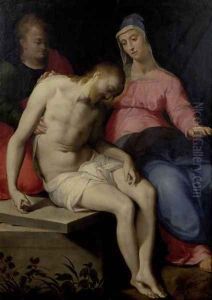Lorenzo Sabbatini Paintings
Lorenzo Sabbatini, sometimes also referred to as Lorenzo Sabatini or Sabbattini, was an Italian painter of the Renaissance period. Born in Bologna in 1530, he was a product of the Bolognese School, which was prominent in the 16th century. Sabbatini initially trained under his father, who was a minor painter, before becoming a student of Prospero Fontana, one of the leading painters in Bologna during that time. His style was also influenced by the works of Pellegrino Tibaldi and Parmigianino, characterized by a graceful, mannerist approach to painting that emphasized elegant forms and sophisticated compositions.
During his relatively short life, Sabbatini worked on various significant projects and gained the patronage of important figures. He was noted for his religious compositions, which adorned many churches in Italy. His works can be seen in the church of San Giacomo Maggiore and the chapel of the Rosary in Bologna, where his skill in fresco and oil painting is evident.
In 1570, Sabbatini was invited by Pope Pius V to work in Rome. This opportunity led him to collaborate with other prominent artists of the time, including Giorgio Vasari, in the decoration of the Vatican. Sabbatini contributed to the frescoes in the Vatican's Sala Regia and the Hall of the Chiaroscuri. Unfortunately, his career was cut short when he died prematurely in 1577, at the age of 47, in Rome.
Despite his early death, Lorenzo Sabbatini left behind a legacy that was appreciated by his contemporaries and later generations. His works are recognized for their vitality and the harmonious blend of Northern Italian and Roman stylistic elements. Sabbatini's contributions to mannerist painting continue to be studied and admired for their artistic value and historical significance in the evolution of Italian Renaissance art.
